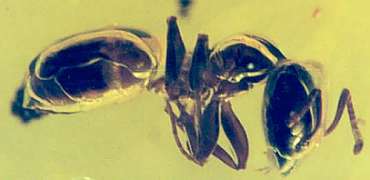Fm. Formicidae - Mrówkowate
Next photos:
1,
2,
3,
4,
Back to Hymenoptera
Taxonomic key, and subfamily name list
subfamilia: Aenictinae
subfamilia: Formicinae
genus:Anoplolepis
genus:Formica
genus:Plagiolepis
genus:Prenolepis
subfamilia: Myrmicinae
subfamilia: Dolichoderinae
genus:Ochetellus
genus:Dolichoderus
subfamilia: Leptanillinae
Ants are placed in a single family, the Formicidae. They belong to the order Hymenoptera, which includes bees, wasps, sawflies, and ichneumons.
A characteristic of most formicids is the possession of a metapleural gland. This gland produces phenylacetic acid, which fights against fungi and bacteria. It is made up of a pair of cell clusters which lead to two chambers in the rear of the ant's middle body. While the gland is the most diagnostic trait separating ants from other Hymenoptera, it is not universal among ants. Many arboreal species lack the metapleural gland (due perhaps to the drier, cleaner environment). Another trait that characterizes ants is their body structure. The ant head is connected by a thin neck to the thorax, which is then connected by a thin "waist" to the abdomen. While this is the general structure of many insects, ants are distinguished by the waist, which is pinched down posteriorly at its connection with the abdomen.
Native ants can be found everywhere in the world, excluding Antarctica, Iceland, Greenland, parts of Polynesia, and a few remote islands in the Atlantic and Indian Oceans. Within this vast range, 8,800 species have been documented, although upwards of 20,000 species have been estimated to exist. An exact figure would be exceedingly difficult to determine, since many species are difficult to differentiate. Ants can live in nearly every terrestrial habitat and environment, including deserts, beaches, in walls, and abandoned plumbing. Some species have even been known to survive underwater for as long as fourteen days by going into an anesthetized state, in which oxygen intake decreases to twenty times below the need of the ant when asleep.
Ants have a highly structured social system, a feature which has developed in only a few insects, including termites, bees, and wasps. Two or more generations coexist, with the adult ants caring for the young. Ants are divided into castes, with reproductive queens and kings, and sterile workers (all of which are female). Ant colonies vary greatly in their social structure, but three basic stages in the development and life of a colony exist. The first of these is the founding stage, in which a young virgin queen (female alate) leaves the nest of her mother. She flies until she has met and been inseminated by a few males. The males soon die without returning to their nests. Then the female finds a suitable place in the soil or in a rotting tree to build her nest. She forages and cares for her first brood until they are adults. Next the colony enters the second stage, known as the ergonomic stage. Now the queen devotes herself to egg-laying while the workers forage, care for the young, and enlarge the nest. This stage, which centers on colony growth lasts for a period ranging from four months to five years, depending on the species of ant. When the colony is a suitable size, it finally enters into the last stage, the reproductive stage. Now new queens and males are produced, which later leave the nest to produce new colonies, beginning the cycle again.

